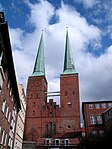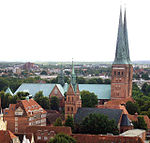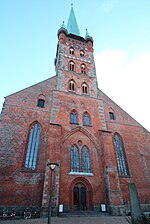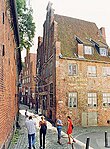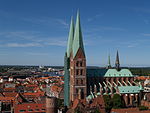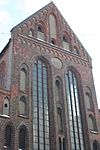Oberschule zum Dom
1905 establishments in GermanyBuildings and structures in LübeckEducational institutions established in 1905Schools in Schleswig-Holstein

The Oberschule zum Dom, a grammar school in Lübeck and the Schleswig-Holstein area of Germany was founded in 1905 during the final years of the German Empire under Kaiser Wilhelm II. The school survived the bombing carried out on the city of Lübeck by the Royal Air Force during the second world war. The School has long been a Gymnasium. It ranks in the top three schools in Lübeck and has always retained a special relationship with archrival the Katharineum zu Lübeck.
Excerpt from the Wikipedia article Oberschule zum Dom (License: CC BY-SA 3.0, Authors, Images).Oberschule zum Dom
Domkirchhof, Lübeck Innenstadt (Innenstadt)
Geographical coordinates (GPS) Address Nearby Places Show on map
Geographical coordinates (GPS)
| Latitude | Longitude |
|---|---|
| N 53.861111111111 ° | E 10.6875 ° |
Address
Domkirchhof 1-3
23552 Lübeck, Innenstadt (Innenstadt)
Schleswig-Holstein, Germany
Open on Google Maps
